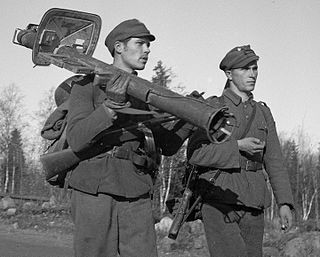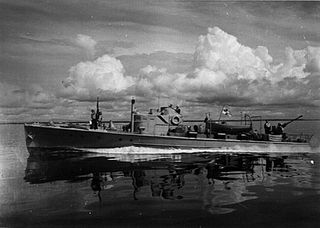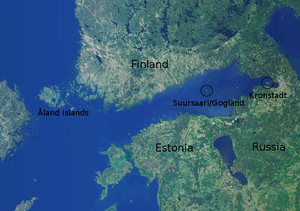
The Finnish Navy is one of the branches of the Finnish Defence Forces. The navy employs 2,300 people and about 4,300 conscripts are trained each year. Finnish Navy vessels are given the ship prefix "FNS", short for "Finnish Navy ship", but this is not used in Finnish-language contexts. The Finnish Navy also includes coastal forces and coastal artillery.

Ilmarinen was a Finnish Navy Panssarilaiva, Swedish Pansarskepp. The unit was constructed at the Crichton-Vulcan shipyard in Turku, Finland, and named after the mythological hero Ilmarinen from the Finnish national epic, the Kalevala. Ilmarinen was the flagship of the Navy from 1 May 1933 until her sinking on 13 September 1941.
Vesikko is a submarine, which was launched on 10 May 1933 at the Crichton-Vulcan dock in Turku. Until 1936 it was named by its yard number CV 707. Vesikko was ordered by a Dutch engineering company Ingenieurskantoor voor Scheepsbouw in 1930 as a commercial submarine prototype, being the prototype for the German Type II submarines. Purchased by the Finnish before World War II, she saw service in the Winter War and Continuation War, sinking the Soviet merchant ship Vyborg as her only victory. After the cease-fire with the Allies in 1944, Vesikko was retired. Finland was banned from operating submarines after the war and she was kept in storage until she was turned into a museum ship.

The Baltic Sea campaigns were conducted by Axis and Allied naval forces in the Baltic Sea, the Gulf of Bothnia, the Gulf of Finland and the connected lakes Ladoga and Onega on the Eastern Front of World War II. After early fighting between Polish and German forces, the main combatants were the Kriegsmarine and the Soviet Navy, with Finland supporting the Germans until 1944 and the Soviets thereafter. The Swedish Navy and merchant fleet played important roles, and the British Royal Navy planned Operation Catherine for control of the Baltic Sea and its exit choke point into the North Sea.

The Battle of Tornio was the first major engagement between Nazi Germany and Finland in the Lapland War; although hostilities had already begun elsewhere.

Vesihiisi was a Finnish 500-tonne Vetehinen-class submarine that was constructed in the early 1930s. The vessel served in the Finnish Navy during the second World War.

Vetehinen was a 500-tonne Vetehinen-class submarine that was constructed in the early 1930s, which served in the Finnish Navy during the Second World War. The submarine was the first ship of its class of three submarines. The name vetehinen means "merman".

Saukko (Pu110) was a small submarine that served in the Finnish Navy during the Second World War. It was designed not to exceed 100 tonnes, as it was planned for use in Lake Ladoga, and according to the 1920 Treaty of Tartu, no nation was allowed to use naval ships of more than 100 tonnes on the lake. The submarine could be divided into separate sections and transported by rail. The conning tower could be lifted off entirely. The engines were in the aft section and the batteries in the forward section. The name "Saukko" means European otter.

The Battle of Vyborg Bay was fought in the Finnish-Soviet Continuation War (1941–1944).

VMV-class patrol boat was a series of Finnish patrol boats, which served with the Finnish Coast Guard and the Finnish Navy during World War II.

The Battle of Suursaari was fought over the frozen Gulf of Finland on and around the islands of Gogland and Bolshoy Tyuters during the Second World War. After sharp fighting the numerically superior Finnish forces seized the Gogland and Bolshoy Tyuters, and later provided support for Nazi German forces defending Bolshoy Tyuters against Soviet counterattacks.

Naval Detachment K was a Finnish military detachment—specifically, a flotilla that operated on Lake Ladoga during World War II.
Finnish Ladoga Naval Detachment was a Finnish naval unit stationed on Lake Ladoga between 1920–1940 and 1941–1944.

The Battle of Someri took place in the Gulf of Finland during World War II on 8–9 July 1942, between the Soviet Union and Finland. Starting as a modest operation to clear a Finnish observation post from a small island, it became one of the largest surface ship engagements in the Baltic theater.

The Battle of Hanko was a lengthy series of small battles fought on Hanko Peninsula during the Continuation War between Finland and the Soviet Union in the second half of 1941. As both sides were eager to avoid a major, costly ground battle, fighting took the form of trench warfare, with artillery exchanges, sniping, patrol clashes, and small amphibious operations performed in the surrounding archipelago. A volunteer Swedish battalion served with Finnish forces in the siege. The last Soviet troops left the peninsula in December 1941.

During World War II, the Lapland War saw fighting between Finland and Nazi Germany – effectively from September to November 1944 – in Finland's northernmost region, Lapland. Though the Finns and the Germans had been fighting together against the Soviet Union since 1941 during the Continuation War (1941–1944), peace negotiations between the Finnish government and the Allies of World War II had been conducted intermittently during 1943–1944, but no agreement had been reached. The Moscow Armistice, signed on 19 September 1944, demanded that Finland break diplomatic ties with Germany and expel or disarm any German soldiers remaining in Finland.
The Naval warfare in the Winter War was the naval part of the Winter War between Finland and the Soviet Union from 30 November 1939 to 13 March 1940. Overall, the level of naval activity was low. However, Finland had coastal artillery batteries which took part in battles along its coast.

Moshchny is an island in the Gulf of Finland of the Baltic Sea, located some 120 km west of Saint Petersburg. The island is a part of the Leningrad Oblast, Russia. The area of the island is approximately 13.9 km².

The Einsatzstab Fähre Ost, referred to as EFO, was a German naval detachment operated by the Luftwaffe during the Second World War. It saw action on Lake Ladoga supporting other Axis units in the Siege of Leningrad.

Väinö Lahja Richard Valve was a Finnish general, navy commander and the last living member of the Royal Prussian Jägerbattalion 27 formed from Finnish volunteers.















